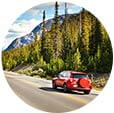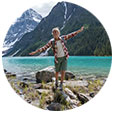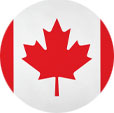The remote and vastly untouched state of Alaska is one of the most popular cruise destinations departing Vancouver. It borders Canada’s Yukon Territory, and Alaska and the Yukon together make the perfect pairing for a wilderness driving holiday. But just what makes this destination so popular? Well, Alaska’s reputation for beauty is firmly founded. It is home to the highest mountain peaks in North America and to some of the last truly wild places on earth. Grizzlies and salmon abound, caribou roam the tundra and eagles soar overhead. Countless glaciers continue to carve the dramatic fjords of the landscape, and there are even volcanic regions and sand dunes.
So get out there and discover Canada’s eight stunning national parks yourself. Find out which you could see on your Alaskan cruise or fly drive:
Wrangell-St. Elias National Park

This is America’s biggest national park. Larger than Switzerland, it is truly vast. It is difficult to get a sense of scale here – the mountains tower impossibly tall (Mount St. Elias stands over 18,000ft), but it is breath-takingly beautiful none the less. One of the best ways to begin to see just how far the wilderness stretches is by taking a flightseeing tour. There are also plenty of hiking opportunities here, from an easy trail to Root Glacier, to more taxing hikes to the ruins of 100-year-old copper mines, Bonanza and Jumbo. The views from the top are worth the effort.
How to get there: You can drive here from Anchorage. It will take a full day, and the journey culminates in a 59-mile gravel road.
Kenai Fjords National Park

Much of it lying under the huge Harding Icefield, this national park is home to dozens of glaciers. The glaciers, over the course of millennia, have carved the dramatic fjords which give the park its name. It is home to some of the most spectacular glaciers – Portage Glacier in Chugach National Forest, and the massive tidewater glaciers, Aialik and Holgate. Hiking at least some of the way up the Harding Icefield Trail rewards you with spectacular views of the valley. Boat tours are the best way to get close to the Glaciers.
How to get there: If you are cruising to Alaska, your ship may dock in Seward, which is just next to the park. You can also drive there from Anchorage down Turnagain Arm.
Denali National Park

If there is any wild and unexplored place left in the world to truly fill one with awe, it is Denali. North America’s highest peak at over 20,000ft dominates the landscape of the 6-million-acre park. Its peak often shrouded in clouds, its dramatic snowy slopes brood over the surrounding tundra. Alaska’s state bird, the ptarmigan, can be spotted here, along with grizzlies, golden eagles and Dall sheep. Once inside the park, shuttle drivers ferry you up the sole road that traverses Denali.
How to get there: This is a straight-forward drive from Anchorage. You can also choose a tour which includes both Denali and an Alaskan cruise.
Gates of the Arctic National Park

This is a National Park only by virtue of the boundary around it. Inside, it is untouched by federal government, and for the most part, untouched by man. There are no roads or trails here. What you will find instead are perfectly preserved ecosystems where Native peoples have lived with the land for thousands of years. Glacier carved valleys sculpt the parks features, where migrating caribou leave the only tracks. The sun doesn’t set in summer, and winter is lit by the aurora.
How to get there: This is one of the most remote and most difficult to reach of the national parks. Access begins at Fairbanks, where you can take a small airline to a gateway community. From there you must take a tiny air taxi or hike.
Glacier Bay National Park

Not content with mere National Park status, Glacier Bay is also a UNESCO World Heritage Site. The glacial landscape is unlike any other, and if you’re lucky enough to be cruising here, you’ll feel that the huge ice sheets are almost close enough to touch. There is more to this vast and complex ecosystem than glaciers, however. The park’s 3.3 million acres encompasses rugged mountain peaks and temperate rainforest too. Keep an eye – and an ear – out for calving glaciers. As huge chunks of ice crack and crumble into the sea, the noise is deafening and water can shoot hundreds of feet high. Glacier Bay has more actively calving glaciers than anywhere in the world.
How to get there: This spectacular landscape can only be seen by boat. The best way is a cruise of the Inside Passage – of which this is a highlight. It is also possible to charter a private boat.
Katmai National Park

This fascinating habitat is an active volcanic region, which protects Mount Katmai and the Valley of Ten Thousand Smokes. The dramatic summit of Mount Katmai contains a vivid blue crater lake. This whole area is an important ecosystem for salmon and brown bears, containing thousands of grizzlies. The famous Brook Falls has been immortalised in photos of brown bears fishing for salmon as they jump up river.
How to get there: Katmai is almost exclusively accessed by plane or boat. It lies about 290 airmiles southwest of Anchorage and an air taxi is your best bet for visiting.
Kobuk Valley National Park

Kobuk Valley National Park may be one of the most unique and intriguing places on the planet. Here are the largest active sand dunes in the arctic. Along the southern banks of the Kobuk River, these giant sand dunes rise suddenly and unexpectedly from the trees. Their surface is criss-crossed by animal tracks. A relic of the grinding motion of glaciers in the last ice age, the dunes are now home to wolves, foxes, bears, and of course, huge herds of caribou as they make their twice-yearly migration.
How to get there: This is one of the most difficult national parks to get to, as it is very remote. There are no roads, so access is by plane from Anchorage and then air taxi from Kotzebue or Bettles.
Lake Clark National Park

Lake Clark’s mountains and waterways are stunning. Volcanically active features steam in the crisp air. Lakes shimmer a deep turquoise. Here, brown bears are numerous – as are the salmon they feast on – and the chances to views these beautiful animals in the wild are plentiful. The local people are warm and welcoming, ready to share countless generations of culture with you. The remote four million acres of the park support an ongoing tradition of subsistence farming.
How to get there: Like other national parks in Alaska, Lake Clark is not on the road system. Access therefore is by air. It is roughly 120 airmiles southwest of Anchorage.







